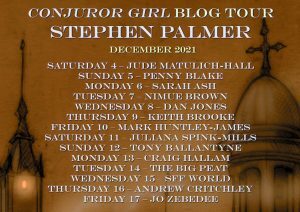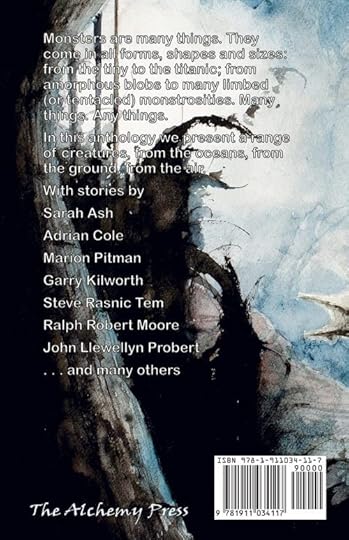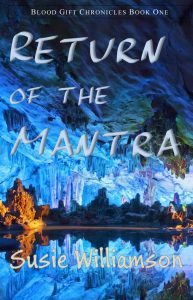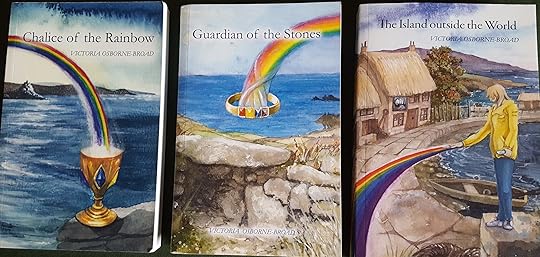Sarah Ash's Blog, page 3
December 6, 2021
Conjuror Girl – Stephen Palmer visits the Guest Blog to talk about his new trilogy
“Why can’t a woman be more like a man?” Professor Higgins sings in My Fair Lady. “Men are so honest, so thoroughly…” Hmm, let’s stop the record there and change that opening line.
Why can’t a man be more like a woman? What is it that’s stopping them? Do they believe they have more to lose than to gain by ditching traditional masculinity? Are they frightened by or disgusted by women? Are they too immature to see the damage they’re doing to women and to themselves? All three of those thing, I think.
In my new Conjuror Girl trilogy, set in 1899/1900, I wanted to portray a scenario in which the main character, Monique, possesses a talent only men are supposed to have. This being a version of Victorian Britain, men are in charge and women lack many of the rights they now have. Monique therefore faces an immediate and pressing dilemma: should she conceal her gift in order to survive in a milieu hostile to women, or should she be true to herself and accept, or even use her talent?
I use art as a metaphor in these books. One of Monique’s true friends is Henri Manguin, a real French painter, who recognises Monique’s artistic gift. But women artists struggled to be seen in the nineteenth century, and Monique has no expectations of success, as with sullen obstinacy she observes: Whoever heard of a woman artist? It’s ridiculous. There’s a marvellous line in the film Portrait Of A Lady On Fire in which Noemie Merlant’s painter character remarks on women not being allowed to paint male nudes so that any talent they might have remains out of sight. Henri Manguin however is not going to allow Monique to remain invisible. He has plans for her.
But the main drama plays out inside Monique’s mind. Her best friend Lily considers the prime task of a young woman to be finding a husband – even orphans, for such are Monique and Lily, may acquire husbands. Monique however is not so sure:
She shook her head. “I’m a freak. I should’ve been born a boy.”
Lily eyed her. “Then you would be stuck in men’s world.”
“But, wouldn’t you rather be there too? Somewhere with control, with influence, where you can do things that people actually notice… and not have to bear children, year after year after year?”
Lily paused for thought. “I want something different,” she said, “but not the men’s world. That’s all fighting, wars and duty.”
“And finer things, like art, and science.”
“Perhaps. Yet if a woman is a scientist she is mocked as an anomaly. Look at Madame Curie, who discovered the miracle of radium yet is treated as a one-of-a-kind. Is that fair?”
Monique shook her head. “Nothing’s fair in this world.”
Monique, being young, is of the age when fairness is the determining factor in ethical decision. She feels depressed at the ways of her world: inimical to women, and indeed to children. Yet the gift burns inside her, and she knows she has to come to terms with it at some level.
I am a man, and thus not qualified to speak from the inside on women’s worlds. Yet I can from the outside. Moreover, because I’m so far from being a traditional man, and because I reject all the tropes and fantasies of traditional masculinity, the position of women in patriarchal society resonates with me. In my youth I was on occasion treated as something less than a man because of my long hair and propensity for enjoying reading and art. I say this only by way of background, not to justify my position. But in the fight against oppression, violence and cultural ignorance, as many hands as possible are needed. In particular men who see the truth of patriarchy need to speak out, especially to their fellow men, in an attempt to steer society towards a more humane future. Such I do in my real life, and as an author.
Why shouldn’t a man be more like a woman?

Stephen Palmer is the author of seventeen genre works: Memory Seed (Orbit 1996), Glass (Orbit 1997), Flowercrash (Wildside 2002), Muezzinland (Wildside 2003), Hallucinating (Wildside 2004) and The Rat And The Serpent (Prime Books 2005). In 2010 PS Publishing published the far-future Urbis Morpheos. In 2014 Infinity Plus Books published his surreal slipstream steampunk novel Hairy London, and in 2015 his Beautiful Intelligence and short novel No Grave For A Fox. Ebooks of Muezzinland, Hallucinating and The Rat And The Serpent are available from Infinity Plus, who have also published the ebooks of Memory Seed, Glass and Flowercrash. In 2016, Infinity Plus published his alternate-world steampunk Factory Girl trilogy; The Girl With Two Souls / The Girl With One Friend / The Girl With No Soul, with another alternate historical work, Tommy Catkins, out in summer 2018. In 2019 IP published a return to themes of AI, The Autist. Following the relaunch of the Factory Girl trilogy later in 2019 with new Tom Brown covers, IP published a fourth work in the same world, The Conscientious Objector. Woodland Revolution, a mythic prose-poem, came out in 2020. His short stories have been published by Wildside Press, Spectrum SF, Newcon Press, Infinity Plus, Mutation Press, Eibonvale Press, Solaris, TFQ, Unspoken Water, Doghorn Publishing, Kraxon, Tickety Boo Press, The Manchester Speculative Fiction Group, Boo Books, Wayward Plants, Woodbridge Press, the FCC charity, and PS Publishing (forthcoming). In 2019, Newcon Press published a collection of short stories, Tales From The Spired Inn, set in the world of Memory Seed. @ipebooks
Stephen lives and works in Shropshire, UK.
Please Feel Free to Share:





December 4, 2021
Stephen Palmer visits the Guest Blog on December 6th
In an alternate 1899…
I’m delighted to welcome Stephen Palmer to the Guest Blog on December 6th as he launches his fascinating new trilogy Conjuror Girl!

Monique, resident for as long as she can remember at Shrobbesbury Orphanage, has a strange talent, which she neither understands nor can control. This talent, however, is only supposed to be possessed by men.
Should she conceal her abilities in order to survive, or should she be true to herself? If she hides her gift she will languish, yet if she reveals her true self she will be hunted down and experimented upon by men whose talents outshine her own…
A most peculiar adventure through a fantastical alternative fin de siècle Britain where the darkest creations are those that come from within.
Please Feel Free to Share:





October 22, 2021
Here There Be Monsters…
In search of a few delicious chills and thrills in your reading material this Hallowe’en? The Alchemy Press Book of Horrors 3 is just what you’re looking for as, this time, it’s all about the…
Monsters!!
The Alchemy Press Book of Horrors 3: A Miscellany of Monsters edited by Peter Coleborn and Jan Edwards
Monsters are many things. They come in all forms, shapes and sizes: from to the tiny to the titanic; from amorphous blobs to many limbed (or tentacled) monstrosities; from supernatural demons to man-made terrors. They come from any place and time: from under the bed to the woodshed; from the icy wastes to the darkest jungles; from the depths of the ocean to outer space; from the past, the future, the now! Many things. Any things. In this anthology we present a range of creatures, from the oceans, from the ground, from the air. Contributors include Garry Kilworth, Steve Rasnic Tem, Sarah Ash, Adrian Cole, Marion Pitman, Ralph Robert Moore and others.

My story is set in Bath and is my take on a local urban legend: the Beast of Bathwick!
Cover art is by Daniele Serra and the frontispiece art is by Randy Broecker
Interested? You can order your very own copy of The Alchemy Press Book of Horror #3 from the Alchemy Press
Please Feel Free to Share:





September 28, 2021
How Much Folklore Has Been Forgotten? Juliet E. McKenna
When I’m starting work on a new book in my ‘Green Man’ series, I do much the same as Daniel does in these novels, when he realises there’s a new challenge to face. I hit the books and the Internet. A lot of these books are ones I remember from my childhood, when collections of folk tales sat alongside historical and fantasy stories on the school and local library bookshelves. There are interesting things about these books that I simply don’t remember. Thanks to a purchase from an online second-hand bookseller, I’ve discovered that Alan Garner edited one that I vividly recall – A Book of Goblins from Puffin.
Looking deeper into these stories as an adult, I am struck time and again by how much has been forgotten. The Green Man himself is a case in point. The foliage face motif in various forms can be found all over Europe in carvings across the centuries. I have photos of him from a museum in Zagreb. But what does this iconic face signify? We can only guess. Whatever tales were told to explain this mysterious being must have fallen out of favour, and so they’ve been lost in the mists of time. New stories are being woven by modern pagans and novelists alike these days, and I wonder which tales will endure.
This isn’t a recent phenomenon. In The Green Man’s Silence, Dan encounters a spirit of the waters of England’s Fenland. He tells Dan his name is Wade – and I am indebted to my friend Julia Cresswell for drawing my attention to this particular mythic figure. But who was Wade, and what was the significance of his boat? Geoffrey Chaucer knew, and clearly the tales were so well known in his day that he only needed to make a passing reference in The Merchant’s Tale for everyone to get the joke. An editor of Chaucer’s works in the 16th century notes that the story of Wade is long and fabulous, but he sees no need to repeat it. Modern scholars can only curse Thomas Speght for his laziness. By the 19th century, the Old English Tale of Wade was reduced to a few inexplicable manuscript fragments in the library of Peterhouse, Cambridge. There are no real clues in the various places around the country linked to his name, such as Wade’s Grave and Wade’s Causeway in Yorkshire. How do the scraps of local legends explaining standing stones and other features in the landscape relate to Wade’s wider story? Unless some lost manuscript turns up, we will never know.
Some fleeting references in folk tales say that Wade was the father of Wayland, the famous smith. He’s another mythic figure whose full story has been lost. Tradition ties him to Wayland’s Smithy high on the Wessex Downs, and local legend says that’s where the Uffington White Horse goes to get a new set of shoes once a century. The Uffington Horse is perhaps England’s most famous chalk figure, but we have no real idea of who first carved it and why, even if modern archaeological technology is helping to narrow down when. At least as much mystery, if not more, surrounds other surviving landscape figures such as Wiltshire’s other white horses, the Cerne Abbas Giant, and the Long Man of Wilmington. Then there are the carved horses and giants which have been lost, now only known from written references. Why did people go to so much effort to create such things, and to maintain them for centuries? Any number of theories have been put forward over the decades. Can we ever know who’s right? I very much doubt it.
Giants are a real curiosity in British mythology. According to Geoffrey of Monmouth writing in the 12th century, their savage race held these islands until courageous men arrived to drive them out. Geoffrey also claims that giants built Stonehenge, and a medieval giant effigy survives in Salisbury Museum, once linked to the local Tailors’ Guild. Brief stories of local giants being killed by local heroes crop up in many of the books of regional folklore that I like to pick up whenever I can. We all know the fairy tales of Jack and the Beanstalk, and Jack the Giant Killer. But we have no idea where these stories came from, especially the ones about assorted Jacks. Scholars have traced those particular pantomime favourites back to the late 17th century, but they can find nothing to explain why they suddenly came into fashion at that time.
What does this mean for me as a novelist? Well, I find myself with references and scraps of folklore dotted all over the map. The challenge for me is joining up those dots to create a coherent story. What does this mean for Daniel, when there’s rumour of a giant roaming the beech woods and the chalk hills of Wiltshire, and the Green Man expects him to deal with the problem. He can’t find any answers in old books or posted online. That means he has to go looking for help from other spirits bound to the trees and landscapes of the Wessex Downs. The challenge for him will be convincing them that he’s a friend not a foe. If you’re curious to know how he gets on, The Green Man’s Challenge is available from Wizard’s Tower Press, or through your preferred retailer.
Please Feel Free to Share:






September 27, 2021
Juliet E. McKenna visits the Guest Blog to delve into the legendary roots of The Green Man’s Challenge
Fans of Juliet E. McKenna’s hugely successful Green Man series have been eagerly awaiting the arrival of the fourth volume: The Green Man’s Challenge – and now their wait is over as publication date is September 28th from Wizard’s Tower Press and other bookstores!
I’m delighted to welcome Juliet back to the Guest Blog on the 28th – drop by to read her fascinating and informative thoughts as she asks: How Much Folklore Has Been Forgotten?
Please Feel Free to Share:





June 23, 2021
Scent of Lilies – Cover Reveal for the New Paperback Edition!
‘A ghost story set in the ember years of the Byzantine Empire.’
Edward Miller has created wonderfully atmospheric new artwork for the cover of the brand-new Scent of Lilies paperback and e-book edition – who better to illustrate a story with such strong supernatural elements than an artist with such an impressive portfolio of covers for horror and fantasy fiction!
After being unavailable for six months, Scent of Lilies is back – and better than ever as readers who prefer a physical edition can now own their own paper version.
Please Feel Free to Share:





April 19, 2021
Emperor of the Fireflies available in paperback!
I’m delighted to announce that Emperor of the Fireflies, the second book in the Tide Dragons series, is now available to buy in paperback with wonderful newly enhanced cover art by Marcelle Natisin!
Emperor of the Fireflies: Amazon.co.uk: Ash, Sarah: 9798724157766: Books
Amazon.com: Emperor of the Fireflies (9798724157766): Ash, Sarah: Books
Emperor of the Fireflies: Ash, Sarah: 9798724157766: Books – Amazon.ca
Emperor of the Fireflies: Ash, Sarah: Amazon.com.au: Books
Please Feel Free to Share:






March 29, 2021
Blood Gift Chronicles – Susie Williamson introduces the second book of her fantasy series
Thank you for inviting me to guest with you, Sarah. I’m delighted to bring along my fantasy series, Blood Gift Chronicles.
The first book in the series, Return of the Mantra, came out in 2018. The story of a young woman’s search for justice and her own identity, a fight back against oppression to restore the old ways. Set in a desertous land, the natural world has been forsaken. Can it ever be restored? What if the future you are fighting for depends on you? First, Suni has to survive, then she has to accept her significance and her power, then she has to fight. And she is not alone.

Return of the Mantra – What if everything you’re taught to hope for, depends on you?
Book 2, The Warder, is a recent March 2021 release. It’s such an exciting moment to receive that knock on the door and find a box of shiny new books waiting to be opened. That first sight of a brand-new book never grows old. Sigh…
The excitable flurry of the new arrival is yet to fade, and I confess I’m feeling all emotional about these characters I have lived with for the past fifteen years. Both novels were works in progress for many years, adding layers to the world, the scenes, the story arcs and characters. One of the best bits for me is seeing how the characters develop as they age and grow, and how they respond to challenges in their changing world. And there is plenty to challenge, from the extraordinary to the more mundane. Finally holding The Warder in my hands makes me smile to think of Suni’s growth into a leader, embracing her gift as she watches over her friend, Wanda, a young man gifted to fly with the hawk.
These books are part of a planned trilogy, connected by an overarching storyline. At the same time, each book is unique, with its own agency and vibe. In Return of the Mantra, we settle in the hot arid land of Shendi, with its coastal town, sprawling deserts and looming mountains. If I listen carefully, I can hear the eagle’s cries ring out from the mountain summits, piercing the skies over the forgotten grasslands. As the series progresses and the world slowly unfolds, we venture into new lands.
The Warder – What would you sacrifice for the ones you love? In a land of gifts and curses, is anything what it seems to be?
Return of the Mantra came to an end, but there remained unanswered questions. How did a King ever become so completely consumed? What is this ancient power that continues to cast a shadow over the land?
And so, The Warder was born, delving into these mysteries as we revisit the land of Shendi ten years on. The story is told from the perspectives of three characters, each possessing gifts that connect them to the land and each other. Can they unravel the mystery in time to save their homeland?
Blurb
The King has been defeated and the spirit of the Mantra has been restored, Suni has been reunited with her father and all is – not quite right.
Wanda and his cousin Luna are living in the valley beyond the mountains: Luna is possessed and dreams of dragons while Wanda, gifted with the ability to communicate with animals, struggles with the curse of Orag. Ntombi blames Wanda for her daughter Luna’s condition.
Meanwhile, in the town by the sea, Suni fears for Wanda, and watches over him using her gift for dreamwalking. Many, including Suni’s father, suffer from a strange affliction and the townspeople are blaming the Mantra.
Then strangers arrive from the sea bringing hope for the town: but in this land of gifts and curses, is anything what it seems to be?
Themes
The books are character-driven, fantasy adventures set in distant but familiar lands, with themes including wildlife and the environment, exploitation and marginalisation, animism, magic, dragons and being true to oneself.
Author Bio

Originally from Yorkshire, Susie started out as a science teacher. She went on to spend four years living and working out in Africa when she was in her twenties, teaching TEFL in the Sudan, and adult literacy in South Africa. On returning to the UK, she settled in Exeter, and worked in a range of support roles, including in a women’s refuge. Over time she increasingly prioritised the time to write.
Published by Stairwell Books, Susie reads widely and is influenced by authors such as Ursula Le Guin, Patricia McKillip and Octavia Butler. She loves working in the fantasy genre for its limitless creativity and flexibility to incorporate contemporary issues. She lives with her wife, Kate, close to the river Exe and a bike ride away from the sea, and loves exploring the Devon surrounds, and taking part in local community projects. When she’s not writing she can be found painting canvases to fill the white-washed walls of home. She also writes a regular blog about writing, books, painting and Devon Life: http://susiewilliamson.blog
Published by Stairwell Books: http://www.stairwellbooks.co.uk/product/the-warder/
Facebook: https://www.facebook.com/SusieWilliamsonAuthor
Twitter: https://twitter.com/SJW_writer
Please Feel Free to Share:






January 18, 2021
“Worlds Beyond Borders: from folklore & fairytales to demons & dystopia” Devon Book Club Fantasy Fortnight
I’m delighted to be taking part in Devon Book Club’s Fantasy Fortnight!
Fantasy fan? Join in tonight (January 18th) on Twitter Devon Book Club (@BookDevon) / Twitter at 8 p.m. for a specially extended Book Hour discussion! Here are some of the books and authors that will be featured:
Book of Fire by Mich EnglishChronicles of the 4 by Marissa FarrarCoat With Long Sleeves by Geoff DuckSealskin by Su BristowThe Fools Gold series by Jude FisherThe Tears of Artamon series by Sarah AshThe Girl In The Red Cape by SuzyThe Third Magpie by MS ClementsPlease Feel Free to Share:





January 15, 2021
Publishing in the Time of Covid-19
To misquote that title by Gabriel García Márquez: publishing in the time of Covid-19.
I write to get away from the everyday, necessary but tedious things we all have to do. And I read for the same reason. I’ve never wanted to read about what I’m surrounded by, or what’s on the news, and that’s been true more than ever during the past year.
So, I write fantasy. But this isn’t an invented planet or land. There are no dragons or clan wars. My trilogy is set in the far west of Cornwall. Fantasy in Penzance? Oh yes. You’ll find cars and smartphones, texts and emails; and, of course, libraries. But there is also magic. And time travel.
My second book came out in April ’19 and for that one I did the same as the first time round: visited venues which might sell it and arranged to give talks. I was surprised to find how much I enjoyed doing these, and I’ve been delighted to discover that grown-ups enjoy being read to. However, my third book came out just before Christmas 2020 and of course talks are out; libraries are closed except for click and collect, and groups aren’t meeting except online. And many of the venues that sold the first two are closed too, from the shop at the sculpture gardens to the café in the little local airport. But I keep hearing that people are reading more than usual, so I must make sure they know about this get-away-from-Covid set of books. Set in 2014 and 2016, with no face masks.
So I’ve done socially distanced deliveries in West Cornwall: place wrapped book on doorstep at pre-arranged time and pick up envelope with money from under the flower pot. Ring doorbell and stand six feet away but ensure the book is picked up by the enthusiastic reader. Others have been posted in succession from the local post office and deliveries checked daily by me, using the Royal Mail Track and Trace system – which works, dare I say it, better than another system of a similar name. Though even Royal Mail are suffering in present circumstances.
As with the previous two, there are a host of practicalities around a newly published book. I should have lots of time for these and other things as everything else is on hold: no writers’ groups, no having coffee with friends or visiting family. Yet somehow it doesn’t work like that, and I don’t seem to have any more spare time than I did before.
However, I should also be writing. A trilogy has three books? Still, the first one was never written with a sequel in mind. After I finished it (some years before I got as far as publishing) I was feeling bereft – till one day I had an idea about what might happen next. It was very similar with the third, although that time it was an idea about how to combine the main characters from the first two books with two new characters that I was keen to introduce. And to use a story about an island cut off from the world by magic, which I’d first written about half a lifetime ago. So that’s what I did, and it became The Island outside the World.
I’m going to share something which I haven’t posted in public before. In the opening pages of Book 1, my heroine Gerry has gone into a jeweller’s shop in Penzance. She’s about to leave when a small, silver-haired woman comes into the shop, holding a watch and asking if they can check if the watch needs a new battery. Well, that’s me. I go into that shop every two years or so to see if I need a new battery for my watch. When I tell people this, they always say it’s like Hitchcock’s cameo appearances in his films. I don’t do it again in the whole Jewels of the Rainbow trilogy. But I’ve just started a possible new book. It begins at our local airport. I love the place. Tiny planes taking 16 passengers, yes, one-six, on 15-minute flights to Scilly. Only two check-in desks and jolly good coffee. And they’ve sold my books since the first one came out in 2018 – or did, until the café closed in January 2021. So, three books after I wandered into a jewellers’ in Penzance in Chalice of the Rainbow, a small silver-haired woman is looking at the books for sale beside the counter in the airport café. This time it’s me checking to see if they’ve sold any more of my books since I was last there. My narrator doesn’t know that; all she sees is that the person she’s looking for isn’t in the café. The readers don’t know it either. The story begins four years after the end of the first book, so no one will make the connection. Except people I’ve told about it. Book 3 was set a couple of years after the first two, and I introduced two new main characters in it. I like them so much that I wanted to see them again. I’ll just have to see how this one works out. But you can’t have the fourth book of a trilogy. Can you?

The woman on the cover of Book 3 is wearing the ring from the cover of Book 2, which is why she’s got a rainbow coming from her hand.
About the author:
Victoria Osborne-Broad was born and grew up in London, with Scottish parents, and has an accent which switches to Scots or East London as it chooses. She has been reading for as long as she can remember, and worked in libraries for thirty years. Victoria began visiting Cornwall in 1991 and has now lived there for nearly twenty years. The Jewels of the Rainbow trilogy draws heavily on the Cornwall she knows and loves.
The books in the trilogy – Chalice of the Rainbow, Guardian of the Stones and The Island outside the World – are available as paperback and e-book from www.victoriaosborne-broad.co.uk and on Kindle from Amazon. You can also follow Victoria Osborne-Broad – Author | Facebook aka https://facebook.com/osborneb
Please Feel Free to Share:









